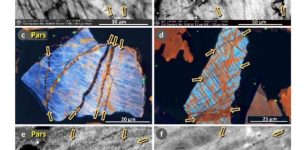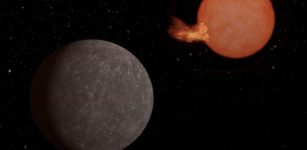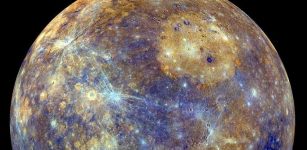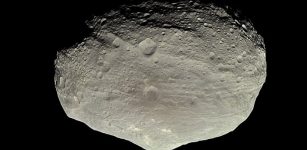Venus Has Almost No Water And A New Study Reveals Why
Eddie Gonzales Jr. – MessageToEagle.com – Planetary scientists at the University of Colorado Boulder have discovered how Venus, Earth’s scalding and uninhabitable neighbor, became so dry.
In Venus’ upper atmosphere, hydrogen atoms, orange, whiz into space, leaving behind carbon monoxide molecules, blue and purple. (Credit: Aurore Simonnet/LASP/CU Boulder)
Using computer simulations, the team found that hydrogen atoms in the planet’s atmosphere go whizzing into space through a process known as “dissociative recombination” — causing Venus (which wasn’t always such desert) to lose roughly twice as much water every day compared to previous estimates.
The results could help to explain what happens to water in a host of planets across the galaxy.
“Water is really important for life,” Eryn Cangi, a research scientist at the Laboratory for Atmospheric and Space Physics (LASP) and co-lead author of the new paper, said in a press release.
“We need to understand the conditions that support liquid water in the universe, and that may have produced the very dry state of Venus today.”
“Venus has 100,000 times less water than the Earth, even though it’s basically the same size and mass,” said Michael Chaffin, co-lead author of the study and a research scientist at LASP.
The researchers report that a molecule called HCO+ (an ion made up of one atom each of hydrogen, carbon and oxygen) high in Venus’ atmosphere may be the culprit behind the planet’s escaping water.
“We’re trying to figure out what little changes occurred on each planet to drive them into these vastly different states,” said Cangi, who earned her doctorate in astrophysical and planetary sciences at CU Boulder in 2023.
Scientists suspect that billions of year ago during the formation of Venus, the planet received about as much water as Earth. At some point, catastrophe struck. Clouds of carbon dioxide in Venus’ atmosphere kicked off the most powerful greenhouse effect in the solar system, eventually raising temperatures at the surface to a roasting 900 degrees Fahrenheit. In the process, all of Venus’ water evaporated into steam, and most drifted away into space.
But that ancient evaporation can’t explain why Venus is as dry as it is today, or how it continues to lose water to space.
“As an analogy, say I dumped out the water in my water bottle. There would still be a few droplets left,” Chaffin said.
On Venus, however, almost all of those remaining drops also disappeared. The culprit, according to the new work, is elusive HCO+.
Missions to Venus
Chaffin and Cangi say that in planetary upper atmospheres, water mixes with carbon dioxide to form this molecule. In previous research, the researchers reported that HCO+ may be responsible for Mars losing a big chunk of its water.
On Venus HCO+ is produced constantly in the atmosphere, but individual ions don’t survive for long. Electrons in the atmosphere find these ions, and recombine to split the ions in two. In the process, hydrogen atoms zip away and may even escape into space entirely — robbing Venus of one of the two components of water.
Scientists have never observed HCO+ around Venus, probably due to the lack of proper instruments.
Missions that visited Mars in recent decades did not carry instruments capable of detecting the HCO+ that powers the team’s newly discovered escape route.
“One of the surprising conclusions of this work is that HCO+ should actually be among the most abundant ions in the Venus atmosphere,” Chaffin said.
NASA’s planned Deep Atmosphere Venus Investigation of Noble gases, Chemistry, and Imaging (DAVINCI) mission will drop a probe through the planet’s atmosphere all the way to the surface. It’s scheduled to launch by the end of the decade.
DAVINCI won’t be able to detect HCO+, either, but it might reveal more regarding water on Venus.
“There haven’t been many missions to Venus,” Cangi said. “But newly planned missions will leverage decades of collective experience and a flourishing interest in Venus to explore the extremes of planetary atmospheres, evolution and habitability.”
Written by Eddie Gonzales Jr. – MessageToEagle.com Staff Writer











